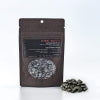
Microplastics have been nicknamed the invisible invasion. Microscopic bits of plastic are now commonly found in food, water, and air. We are just beginning to understand the effects this contamination has on our bodies. And avoiding exposure isn't easy. Researchers are even finding microplastics in remote natural spaces that should be pristine.
These microplastics are made up of a lot of different chemicals. Some we are still learning about, but others are infamous, such as BPA, phthalates, PVC, or PFAS. We know these chemicals can disrupt your hormones, thereby affecting reproduction and metabolism and in some cases increasing your risk of cancer. Studies are beginning to also draw correlations between the presence of microplastics in a person's arteries and the likelihood of experiencing heart attack, stroke, allergic reactions, skin irritations, or respiratory problems.
Minimizing Microplastic Exposure
While it is difficult to avoid microplastics altogether, making mindful choices can help limit your daily exposure. Seek alternatives to plastics. For example, switching to glass or ceramic food storage containers or a stainless steel water bottle. When you shop for home goods, look for natural materials like wood or linen.
Pesticides may also contribute microplastics, so sticking with organic foods is another good preventative measure. And avoid packaged or processed foods that are more likely to contain microplastics as well as other unnecessary chemicals. A balanced, whole foods diet continues to be the gold standard for health and wellness. Whole foods have natural anti-inflammatory and antioxidant properties to help your body fight against contaminants.
Good clean water is also essential. You might look into Shungite water purification or have a more advanced system installed. Along the same lines, a HEPA filter may aid in eliminating microplastics in the air you breathe.

Microplastic Detoxification Pathways
All these steps can help to reduce your exposure. But what about the unavoidable microplastics or those you've already absorbed? Studies indicate that microplastics can be carried and stored anywhere in our bodies, including into our brains and reproductive organs. Fortunately, there are easy steps you can take towards detoxifying microplastics from your body. Choose whichever combination works best for you.
Sweat Elimination
Your body has built in detoxification pathways. One of those is through sweating. Sweating eliminates toxins from your body, including microplastics. Studies suggest more microplastics are eliminated through sweat than through urine. Regular workouts or sauna sessions can promote this function.
Breathing Exercises
Deep breathing helps your body eliminate toxins from your lungs. Practice deep breathing exercises by inhaling for a count of five, holding the breath in for a count of five, and breathing out for a count of five. A consistent deep breathing practice may also reduce anxiety, expand your lung capacity, and increase the availability of essential oxygen for whole-body health.
Increasing Fiber Intake
When you ingest microplastics hidden in food or water, they move through your gastrointestinal track where they are broken down before entering the circulatory system. Consuming more fiber speeds up digestion and helps your body expel microplastics as waste. Help your body detox microplastics by adding high fiber foods to your diet, such as nuts and legumes, fruits, vegetables, and whole grains.
Detoxifying Supplements
Another way to assist the body's natural detox systems is with supplements. When you ingest microplastics, the liver and kidneys must do extra work to counteract the effects. Antioxidant supplements like Vitamin C, Glutathione, or N Acetylcysteine may support detoxification and help protect cells from toxins (Zhitkovich, 2019).
Intermittent Fasting
Some research suggests another way to support healthy elimination of toxins like microplastics is through intermittent fasting, preferably with an eating window earlier in the day. This way your body can perform essential tasks as you sleep, without fussing with digestion. Strategic calorie restriction may help the body breakdown and release plastic chemicals that have been stored in fat tissues. After the stored microplastics are extricated from fatty tissues, they move to the skin where they can exit through sweat glands.
Moving Forward
Because microplastics are so prevalent and exposure is near impossible to avoid, it is essential to know how to support healthy detoxification to eliminate them from your body. If you're unsure how or where to begin, consider reaching out to Rose for one-on-one lifestyle coaching and energetic healing. It's easy to schedule a phone consultation with Rose Boghos.
What To Remember:Microplastics are prevalent in beauty products, packaging, and even the water we drink.
Eliminating microplastics from your body may revitalize your energy levels. It may also reduce your risk of hormonal imbalance, reproductive problems, or chronic disease. The solution is a simple microplastic detox. |
If you don’t take care of this the most magnificent machine that you will ever be given, where are you going to live? – Karyn Calabrese |

Resources:

*This blog contains Amazon and EMF Rocks affiliate links. The owner of this site may receive a small commission if you click a link and make a recommended purchase.
